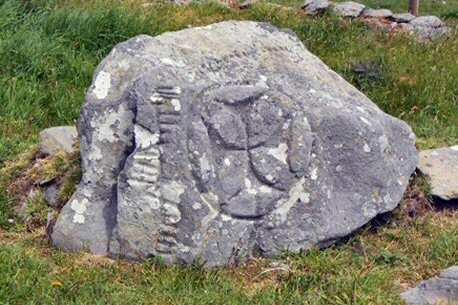Type: Ogham & Cross Inscribed
Townland: Mám an Óraigh᚛ᚐᚅᚋ ᚉᚑᚂᚋᚐᚅ ᚐᚔᚂᚔᚈᚆᚔᚏ᚜
Hill-top of the Yellow Stones or Mountain Pass of the Hoares.

'An Early Christian church site Kilcolman (Cill Cholmáin) lying on the S slopes of an E-W spur of Lateevemore, overlooking Ventry Harbour.
It consists of a circular enclosure within which are the reputed site of a church, the foundations of a least two huts and a number of graves and gravemarkers which probably relate to the use of the site, until the 19th century, as a calluragh burial ground (OSNB Marhin, 14).
Also within the site are a cross-inscribed ogham stone, a small cross inscribed stone, a holed stone and 3 bullaun stones. Another cross-inscribed stone has been incorporated into the lane boundary wall on the N side of the field in which the enclosure is situated, and S of the enclosure is a holy well dedicated to St. Brendan'
'A large irregularly-shaped boulder, its W face inscribed with an ogham inscription and 2 crosses... The main cross motif is a deeply inscribed cross of arcs within a circle, its lower arm linked to the circle by a short stem.
The latter continues beyond the circle to below the present ground surface and exhibits a triangular expansion at about its mid-point. An equal-armed cross with fishtail like terminals occupies the upper right portion of this face of the stone' Grit 1.15m x 1.58m x 0.54m
'The stem line for the ogham was carved up the left side of the face and across the top, framing the crosses. The ogham scores are clearly legible but the inscription is confused and puzzling. Macalister's ingenious interpretation may be correct... and that the peculiarities can be explained as an attempt to correct mistakes made during its execution' (Cuppage 1986, 333-4).
'The intention of the stone-cutter was obviously to write ANM COLMAN AILITHIR `Name of Colman the Pilgrim'. But he has blundered so badly that he has made the decipherment of the inscription a very difficult matter. At best, the inscription is a `scholastic' essay.
On the vertical part of the stem line he wrote ANM COL. He then realized that if he continued here he would have his
N at the angle, and, consequently, awkwardly cramped; or else, if he carried on past the angle, it would run into the B-half of the
M. Accordingly, he skipped the angle and wrote MAN on the horizontal branch of his stem-line.
He then wrote AIL, the beginning of AILITHIR, before he saw that this word would have to be shortened to fit into the available space, which he had rashly reduced by cutting the second cross.
A feeling of reverence may have prevented him from making room for himself by breaking this away. Accordingly, he squeezed an L into the space between the A and the I - its cramped nature is obvious - thus abolishing the first I of the word AILITHIR, and adapting the I which he had already fashioned to represent the second I of this word.
He next had to dispose of the
L which was already on the stone, and for which he would be obliged to substitute a
T. This he ingeniously effected by cutting a line joining the distal ends of the two scores, thus turning these underline scores into overline scores, and then adding one more, and only one, in the orthodox position above the main stem-line. This gave him the three overline scores of the
T.
He then proceeded with the final
IR, which just filled the available space, though it went beyond the range of the stem line which he had laid out at the beginning. In order to make his correction clear, he wrote in the turn of the angle of the stem line, which still remained blank, the letters O.L.Th - the Th being represented by the O-forfid - meaning ó L, Th- 'from L [make] Th''
For further information: Ogham in 3D
ANM COL(OLṬḤ)ṂẠṆ ẠḶỊṬḤIR.
Translation'name/inscription of Colmán the pilgrim'?.
Site recorded by:Rob Shaw